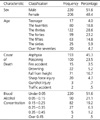Abstract
The purpose of this study is to provide a fundamental basis for defining measures to prevent suicide by specifically examining the relationship between suicide and alcohol consumption, which is thought to be a key factor in suicide. This study reviewed 426 suicide autopsies diagnosed by the department of forensic medicine, National Forensic Service (2007-2009) and analyzed the preliminary data on variables such as gender, age, and cause of death, with particular focus on the relationship between these variables and blood alcohol concentration. The relationship between each variable and alcohol consumption was as follows. First, alcohol was present in 48.4% of suicides. Second, blood alcohol concentration wrere twice as high in women as in men. Third, the relationship between suicide and alcohol consumption was greater in people in their 30s and 40s. The correlation between suicide and alcohol intake was evident this age group. These results are more specific and practical than the results of previous studies on the correlation between suicide and alcohol intake. The results of this study will help define measures to facilitate suicide prevention as an important reference and may eventually help lower the suicide rate in Korea.
Figures and Tables
References
1. 2010 Cause of Death Korean National Statistical Office. Korean National Statistical Office. 2011. Seoul: Available at http://kostat.go.kr.
2. Mclntosh JL. Suicide. USA. Official final data. 2000. Available at http://www.suicidology.org.
3. Jung SH. The socioeconomic burden of suicide and depression in South Korea National Seoul Hospital. 2005. Seoul:
4. Kim HC. A study on the characteristics of adult suicide and suicidal type. Korean J Psychol Soc Issues. 2006. 12:15–33.
5. Powers RJ, Kutash IL. Alcohol, drug, and partner abuse. The Abusive Partner: An analysis of domestic battering. 1982. New York: Van Nostrand and reinhold company.
6. American Foundation for Suicide Prevention. Available at http://www.afsp.org.
7. Wasserman D, Varnik A, Eklund G. Male suicides and alcohol consumption in the former USSR. Acta Psychiatrica Scandinavica. 1994. 89:306–313.
8. Lee HK, No SW. The relations of alcohol drinking behavior, depressive mood, and suicidal ideation among korean adults. J Korean Alcohol Sci. 2011. 12:155–168.
9. Yoon MS, Kim SH, Chae WS. The effects of alcohol use, mental health factors on seniors' ideation of suicide. J Korean Alcohol Sci. 2010. 11:27–44.
10. Yoon HW. The association between health risk behavior and suicidal ideation in Korean youth. 2011. Seoul: Korea University;12–25. Master Thesis.
11. Yoon MS, Cho HC. A longitudinal effects analysis of adolescent drinking on the suicidal ideation. J Adolesc Welf. 2011. 13:43–66.
12. Chung SG. Influence of early onset of drinking and problem drinking on suicide ideation and attempt among korean adolescents: Analysis of 2009 korean youth risk behavior survey. J Korean Alcohol Sci. 2011. 12:15–27.
13. Glaister J. Medical Jurisprudence and Toxicology. 1947. 12th ed. Baltimore: Williams and Wilkins company;124–126.
14. Kim SJ. Drinking experiences of women alcoholics: A feminist approach. J Korean Acad Psychiatr Ment Health Nurs. 2006. 15:362–374.




 PDF
PDF ePub
ePub Citation
Citation Print
Print






 XML Download
XML Download